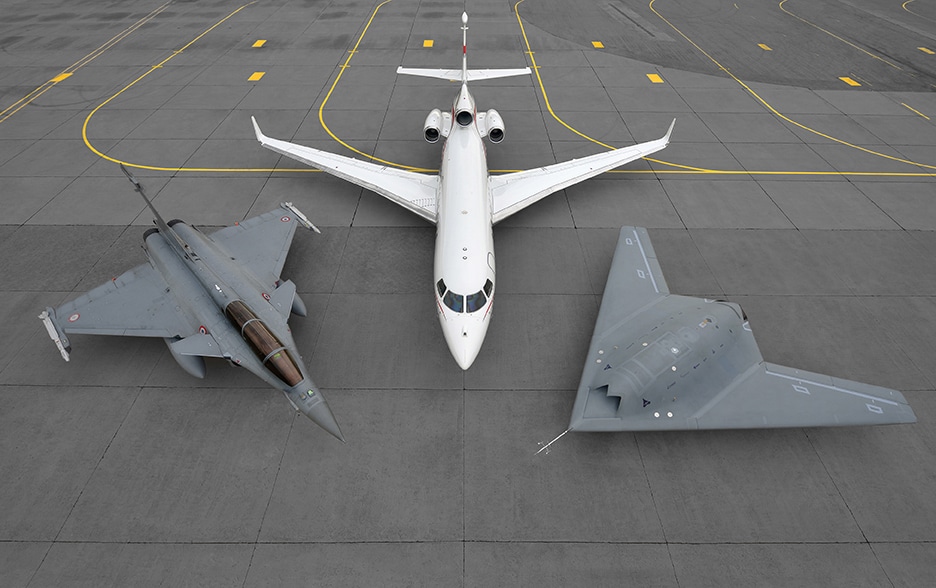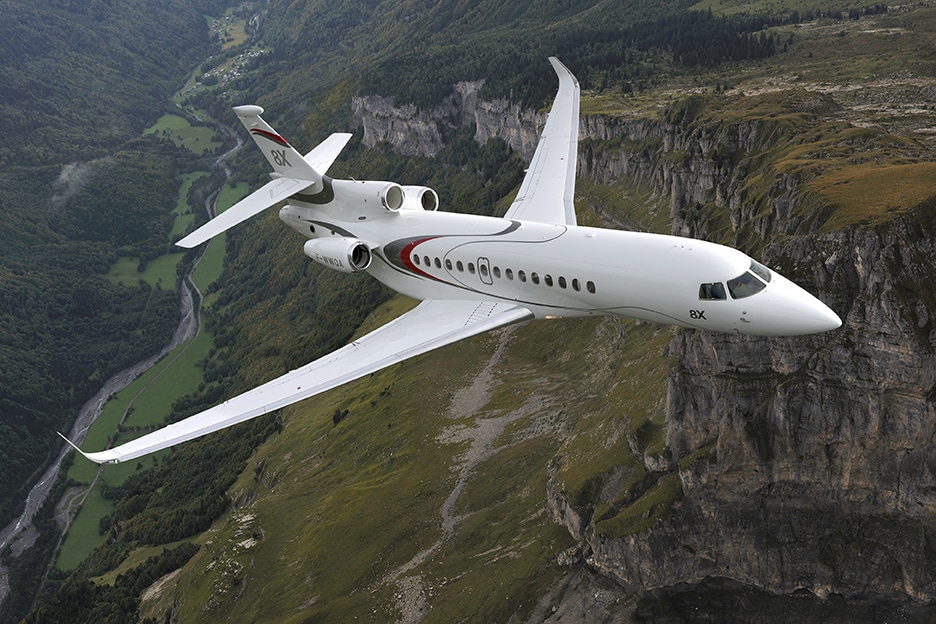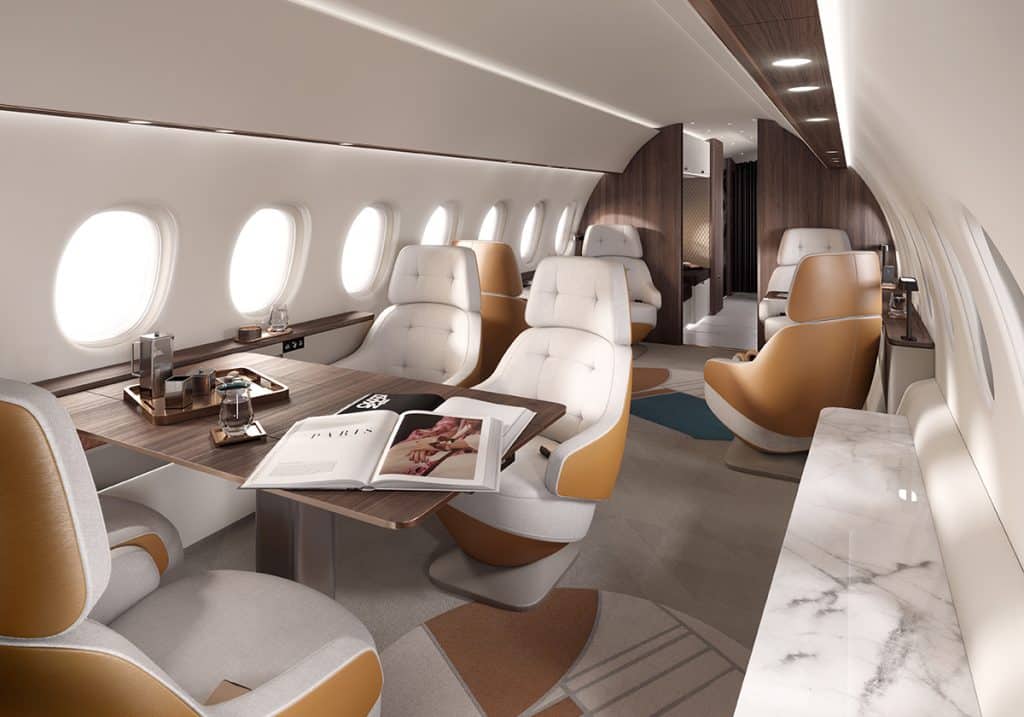Falcon
Dassault Aviation, a division of France’s Dassault Group, manufactures Falcon business jets, known for their performance efficiency and technically-advanced systems, as well as military aircraft, 3D cad/cam engineering systems and aerospace products.
The story of Dassault Aviation begins with a wooden propellor designed during the First World War by 24-year-old Marcel Bloch. The propellor, called the Éclair (Lightning), was simple, rugged and beautiful – hallmarks of Dassault Aviation products to this day. The Éclair was one out of hundreds of propellors selected by the French government to be used in aerial combat in World War I. This breakthrough convinced Bloch to become an aircraft manufacturer himself, and he founded the Société des Avions Marcel Bloch or “MB” – in 1929.
In only a few short years during the 1930s, MB would become France’s second-leading aircraft manufacturer, churning out single-engine transport planes, twin-engine warplanes, and airliners. More than 1,800 civil and military aircraft were produced before the Second World War. However, during the occupation of France by Nazi Germany, the country’s aviation industry was virtually disbanded.
Refusing to work for the occupying forces, Bloch was imprisoned in 1940 and eventually deported to the Buchenwald concentration camp in 1944 where he remained until it was liberated in 1945. After World War II, Marcel Bloch changed his name to Marcel Dassault, and the name of the company was changed to Avions Marcel Dassault in 1947.
From 1945 to 1975, Dassault established itself as one of the leading aircraft manufacturers in the world. In 1954, Dassault established an electronics division, the first action of which was to begin development of airborne radars, soon followed by seeker heads for air-to-air missiles, navigation, and bombing aids. Major successes from this period included the Dassault Mirage fighter jet and the Mystere-Falcon – the precursor to the Falcon family of jets.

After several mergers and acquisitions beginning in the 1960s, the company was renamed Dassault Aviation in 1990. Dassault Aviation remains one of the few aviation companies worldwide to combine civil and military business using the same workforces. This allows it to give business aircraft the same advanced technologies used on combat aircraft, vastly improving the cockpit, digital flight control system, head-up display, flight quality, aerodynamics, and much more.
Applying the company’s long-standing dual production policy, Dassault re-entered the civil aviation market in the burgeoning business jet segment in the 1960s. The Dassault Falcon family of business jets were introduced in 1963 with the Falcon 20, initially known as the Dassault-Breguet Mystère 20. Acting on Charles Lindbergh’s recommendation, Pan Am founder Juan Trippe ordered 40 Falcon 20 jets for U.S. distribution with deliveries commencing in 1965. Due to this early success, a complete range of business aircraft was soon developed.
On top of benefiting from the legacy and technical innovations of Dassault’s combat aircraft, Falcon aircraft offer much-prized cabin comfort: they are exceptionally soundproofed, particularly well-lit, and incredibly spacious. Even those not well-versed with private jet aircraft can likely differentiate a Falcon jet from others, especially with the famous trijet configuration found on some models.
The Falcon 10X, coming in 2025, marks the next waypoint in a storied and successful journey for Dassault. “Dassault Aviation stands apart in its ability to blend high technology – the company is a world leader in aerodynamics and digital flight control – with cabin aesthetics and the inventive use of modern design. The objective is to raise the bar in terms of passenger experience, which is what you will see in the 10X,” said Eric Trappier, Chairman and CEO of Dassault Aviation.
Falcon 8X
CERTIFIED IN JUNE 2016, THE FALCON 8X OFFERS A UNIQUE COMBINATION OF EFFICIENCY AND FLEXIBILITY IN THE HEAVY JET AIRCRAFT SEGMENT.
Its cabin is also the quietest on the market and offers unrivaled comfort with an exceptionally wide choice of layouts. The 8X is up to 20% more fuel-efficient than any other aircraft in the ultra-long range segment. Much of the credit goes to the three highly efficient Pratt & Whitney PW307D engines that power the Falcon 8X.
The model itself is a derivative of the Falcon 7X, with the fuselage stretching an extra 3.6 feet and incorporating EASy III avionics. While it may not seem like a large extension, it translates to a larger galley, more legroom and optional steam shower. With a large cabin also comes more room for customization and optimization: choose a shorter entryway to add more lounge space, or select a large entryway with lie-flat crew quarters or grand galley. There are more than 30 available configurations.
Passengers will enjoy the 33 cabin windows, expanded chill drawers, color-adjustable LED lighting, and very quiet cabin. Air quality also remains high with 20% added humidity and cabin pressure remains very low, staying at 3,900 feet while at a cruising altitude of 41,000 feet. With comforts like this, up to six passengers can sleep soundly in the mid-cabin zone with six-seat conference grouping that function as sleeping berths. For further comfort, a VIP stateroom at the rear of the aircraft that converts to a media room finished with pop-up 32-inch TV screen – or an aft shower and lavatory.
This competitor to the Bombardier Global Express and the Gulfstream 650ER has the high-performing, tri-jet configuration that allows for a range of 6,450 nautical miles. Flying at Mach .8, these lighter wings will allow for eight passengers to travel nonstop from Hong Kong to London or from Beijing to Los Angeles. This wing redesign also means a quick stop on runways in just 2,220 feet at max payload, allowing it to operate out of airports that are inaccessible to competitors such as London City, Lugano or La Môle – St-Tropez.

Falcon 10X
CURRENTLY IN DEVELOPMENT, THE FALCON 10X IS SET TO BE THE LARGEST PURPOSE-BUILT JET IN THE WORLD, AND HAS ALREADY RECEIVED NUMEROUS ACCOLADES FOR ITS GROUNDBREAKING CABIN DESIGN.
The $75 million jet is scheduled to hit the market in 2025 and the intended range is reported to be 7,500 nautical miles at Mach 0.85 (652 miles per hour). This would allow nonstop flight between New York and Shanghai, Los Angeles and Sydney, or Hong Kong and New York. The top speed is reported to be a blistering Mach 0.925 or 709 mph, making it one of the fastest jets on the market.
Both the Falcon 8X and the 10X mark a departure from Dassault’s typically more modest ramp scale, reflecting changing customer demands and a new direction for Dassault. The 10X will compete directly with other Heavy Jets such as the Gulfstream G700 and Bombardier Global 7500. With the largest cabin size and the most advanced and efficient engines in the industry (Rolls-Royce Pearl 10X), the newest aircraft from Dassault is being presented as the new leader of the Heavy Jet category.
While Dassault remains known for producing attractive airframes, it’s the cabin of the 10X that’s getting the most attention. The interior is nearly boundless at 2,780 cubic feet with generous height of six feet eight inches. A modular layout allows room for customization, but Dassault intends to blend the lines between home and jet – which is important given the aircraft’s ability to fly 16 hours at a time.
While the 10X will be large, it will also offer excellent mission flexibility. Taking lessons learned from production of the Rafale fighter jet, the carbon-fiber composite wings for the 10X will be highly swept and immensely strong. Dassault’s know-how in manufacturing precision technology will allow the 10X to access even the most challenging approaches, including London City, the heart of global finance.

Related Stories
Kindred Resort Joins the Jet Linx Elevated Lifestyle Program
Jet Linx welcomes Kindred Resort, Keystone’s new full-service mountain retreat offering ski-in, ski-out access, Campfire Luxury, and connection to Colorado’s alpine spirit.
READ MORE
The Global Safety & Operations Center
Over the last decade, Jet Linx has seen international trips grow by 260%, heavy jet trips by 438%, and total trips by 60%, demonstrating its evolution from national to global operations.
READ MORE
Tap to Takeoff: Inside the New Jet Linx Client Portal App
The new Jet Linx Client Portal is a purpose-built private jet booking app designed exclusively for Jet Linx clients.
READ MORE
Related Stories
Kindred Resort Joins the Jet Linx Elevated Lifestyle Program
Jet Linx welcomes Kindred Resort, Keystone’s new full-service mountain retreat offering ski-in, ski-out access, Campfire Luxury, and connection to Colorado’s alpine spirit.
READ MORE
The Global Safety & Operations Center
Over the last decade, Jet Linx has seen international trips grow by 260%, heavy jet trips by 438%, and total trips by 60%, demonstrating its evolution from national to global operations.
READ MORE
Tap to Takeoff: Inside the New Jet Linx Client Portal App
The new Jet Linx Client Portal is a purpose-built private jet booking app designed exclusively for Jet Linx clients.
READ MORE

Contact Us